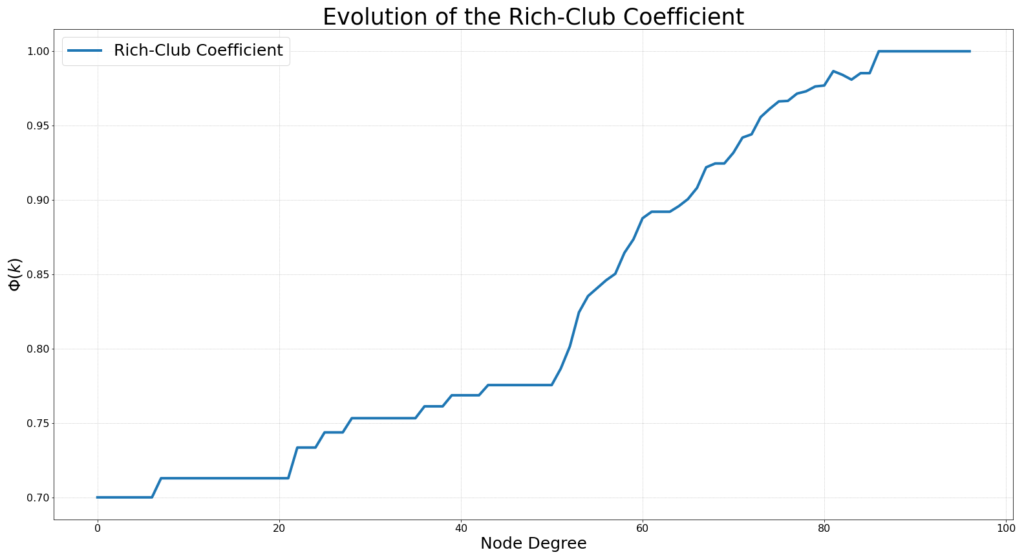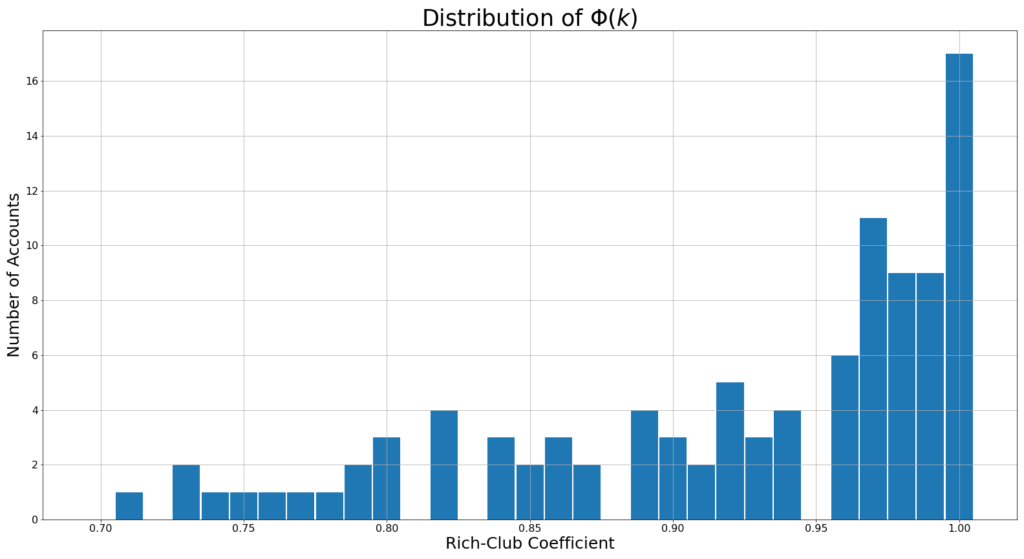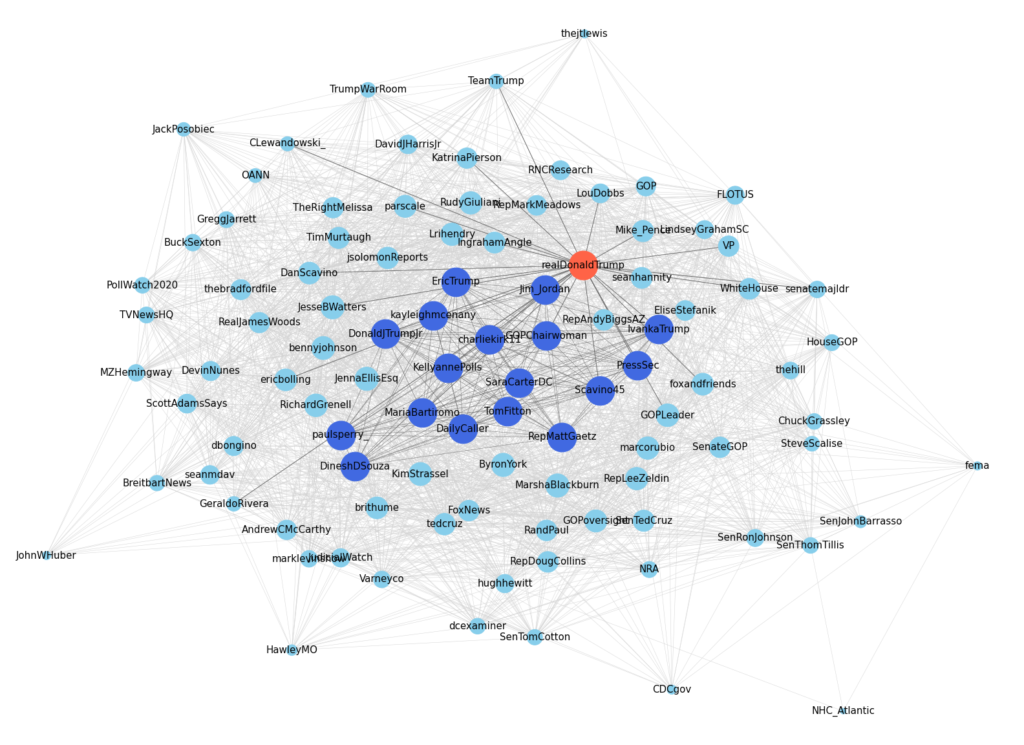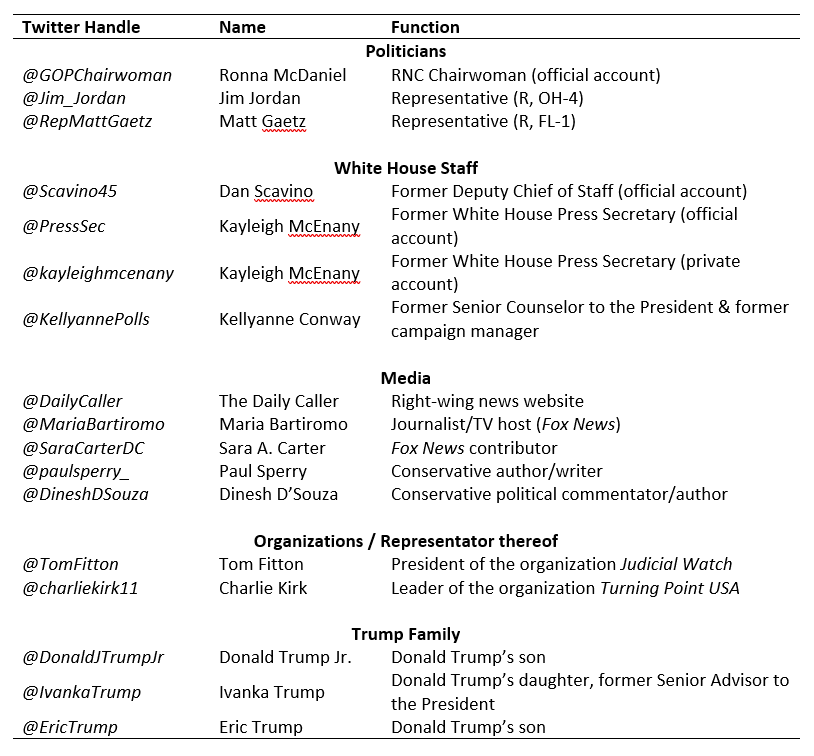
Inside the White House Echo Chamber
Assessing the Rich-Club in Donald Trump’s Twitter Network! In this article, we assess the Twitter network of former U.S. President Donald J. Trump and the people and organizations that are of special importance thereof, indicating potentially enhanced influence on Trump in the digital sphere. To do so, we created a data foundation which allowed us to identify the 100 accounts most often retweeted by Trump as well as the interconnections between these accounts which allowed us to build a network of these accounts. Further analysis utilizing the rich-club algorithm classified these 100 accounts according to their significance within the network. The results show that 17 of these 100 accounts constitute a so-called rich-club within Trump’s Twitter network, indicating their importance.
Introduction
Since Donald J. Trump announced his candidacy for the office of President of the United States on June 16, 2015, his usage of Twitter became a topic of public debate. Bickart, Fournier, and Nisenholtz (2017) assessed that Trump was so successful on the platform because “[his] tweets are unfiltered, spontaneous, and reveal his personal feelings and emotions […], creating the impression that a relationship is in play” and Woodward (2018, p. 206) noted that the tweets were “central” to his presidency.
Based on the importance of Twitter to Donald Trump’s presidency, we wanted to find out who the most important people and organizations in his Twitter universe were. This led to the following research question: “Who are the people and organizations that shape Donald Trump’s world view in the digital sphere?”
Research Design
To answer our research question, we created a network in which those 100 accounts that were most often retweeted by Donald Trump served as the nodes. In our opinion, this approach is suitable since retweeting a tweet is an act actively performed by the user which demonstrates a deliberate interaction. As for the edges, we identified the so-called “friends” for every one of these accounts. In Twitter jargon, “friends” are the profiles an account actively follows, in contrast to “followers” which are acquired “passively” (i.e., a certain account cannot control who follows them, except by blocking other accounts). Figure 1 shows a simplified scheme of our network structure.

After collecting and subsequently cleaning the data with Python’s pandas library, we built the network. To do so, we used the NetworkX library which is specifically designed for building and analyzing networks. To answer the research question, the analysis of the network edges was based on the rich-club coefficient which allows for identifying important nodes within a network. Furthermore, the matplotlib library was used for visualizations.
This research was originally conducted in November and December of 2020. It is therefore important to note that after the storming of the United States Capitol on January 6, 2021, Twitter announced the permanent suspension of Donald Trump’s account on January 8, 2021 after a preceding temporary suspension, citing the “risk of further incitement of violence” among the reasons (Twitter Inc., 2021).
Data
To build our data foundation, we were able to download a comprehensive list of Donald Trump’s tweets from the website Trump Twitter Archive (https://www.thetrumparchive.com/). This data set was used to identify every account Donald Trump ever retweeted since 2009 and filter thereof the 100 accounts he retweeted most often (the Top 100).
We then retrieved the friends for every account in the Top 100 via the Twitter API. This list of friends was then matched with the Top 100 list to filter out accounts that had followers from the Top 100 but were not included in this list themselves. In the end, every Top 100 account had a list stating whom they followed whereby this list of friends only included accounts that occurred in the Top 100 themselves.
This approach would enable us to build a network of those 100 accounts that were retweeted by Donald Trump most often. Simultaneously, we would be able to analyze the edges and therefore identify the most important accounts within this network.
The Rich-Club Coefficient
We decided to assess the importance of individual nodes in the network by utilizing the rich-club coefficient. The rich-club coefficient is a metric designed to quantify the extent to which well-connected nodes within a network are connected to each other. This approach was first introduced by Zhou & Mondragón (2004): “The members of the club tend to be very well connected between each other, they create a tight group where if two members of the club do not share a link, they likely share a common node that can link them […]” (p. 180).
McAuley, da Fontoura Costa & Caetano (2007) further elaborate that the name “rich-club” originates from an analogy where nodes with a high degree (i.e., nodes with a comparatively large number of edges) can be considered “rich” (in connections to other nodes): “[W]hen [this] phenomenon is present, they form ‘clubs’ because they are well-connected among themselves. The relevance of the rich-club phenomenon is that its presence or absence typically reveals important high-level semantic aspects of a complex network” (p. 1).
Results
The implementation of the rich-club algorithm in the NetworkX library follows the definition of McAuley, da Fontoura Costa & Caetano (2007) where the rich-club coefficient Φ(k) is calculated as “[…] the fraction between the actual and the potential number of edges […]” (p.1). It will take a value between 0 (lowest) and 1 (highest). The most important parameter for the calculation is the node degree, i.e., the total number of edges a given node has. We can therefore calculate the rich-club coefficient as the ratio of the number of edges a node has vs. the number of edges it could have. The higher the rich-club coefficient, the better the node is connected within the network compared to other nodes. Figure 2 shows for our data how the rich-club coefficient increases when the node degree increases.

Figure 3 shows the distribution of the rich-club coefficient for the Twitter accounts in our data set. 35 accounts take a value between 0.96 and 0.99, whereas 17 account even reach a rich-club coefficient of 1, proofing the existence of a rich-club. These 17 accounts are therefore (1) very well connected in the network overall and (2) well-connected among each other. These are the accounts that are central to the network and through their own interconnectedness, they are able to connect parts of the network that are not connected otherwise.

Figure 4 is a visualization of the network where the node size represents the node degree. The rich-club is highlighted in dark blue, whereas Trump is highlighted in red. Interestingly, Trump himself is not a member of the rich-club. At the time the research was conducted, Trump only had 52 Twitter friends and not every one of the Top 100 accounts had him as their friend. Therefore, his node degree is considerably lower than the possible maximum. Since the node degree is a very important parameter in the calculation of the rich-club coefficient, Trump’s coefficient amounts to 0.98 which is slightly lower than 1.

Conclusion
It can be assumed that the members of the rich-club in Trump’s Twitter network are the ones that shape(d) his world view in the digital sphere. Not only are they part of the 100 Twitter accounts Trump retweeted most often over the course of almost 11 years. They are also the most integral part of this network of 100 accounts as they are not only well-connected to the entire network, but especially well connected among themselves. The people and organizations identified as members of the rich-club within Donald Trump’s Twitter network are listed in the table below.
Appendix: Table of the Members of the Rich-Club
Note: this table displays the account holders as of December 2020. Official government accounts might have been transferred to representatives of the Biden administration by January 20, 2021.

Author: Salome Isch, Thomas Jenny, Adriana Ricklin
Sources
Bickart, B., Fournier, S, & Nisenholtz, M. (2017). What Trump Understands About Using Social Media to Drive Attention. Retreived 2021-02-05 from https://hbr.org/2017/03/what-trump-understands-about-using-social-media-to-drive-attention
McAuley, J. J., da Fontoura Costa, L. & Caetano, T. S. (2007). The rich-club phenomenon across complex network hierarchies. Applied Physics Letters, 91 (084103), 1—4. doi: https://doi.org/10.1063/1.2773951
The Trump Archive (no date): Trump Twitter Archive V2. Retrieved 2021-02-08 from https://www.thetrumparchive.com
Twitter Inc. (2021): Permanent suspension of @realDonaldTrump. Retrieved 2021-01-31 from https://blog.twitter.com/en_us/topics/company/2020/suspension.html
Woodward, B. (2018). Fear. Trump in the White House, London: Simon & Schuster.
Zhou, S. & Mondragón, R. J. (2004). The rich-club phenomenon in the Internet topology. IEEE Communications Letters, 8 (3), 180—182. doi: 10.1109/LCOMM.2004.823426
Contact us if you have any questions about the degree programme or for individual advice:
Tel.: +41 41 228 42 53 / E-mail: master.ids@hslu.ch
Data is the resource of the 21st century!
Register and join us for a free online Information-Event:
Friday, 28 November 2025 (Online, English)
Monday, 12 January 2026 (Online, English)
Monday, 09 February 2026 (Online, German)
MORE INFORMATION TO THE MASTER’S PROGRAMME HERE:
MORE FIELD REPORTS & EXPERIENCES: Professional portraits & study insights
PROGRAMME INFO: MSc in Applied Information and Data Science
DOWNLOAD BROCHURE: MSc in Applied Information and Data Science Brochure
CHECK OUT OUR: Generalist profile
FREQUENTLY ASKED QUESTIONS: FAQ






